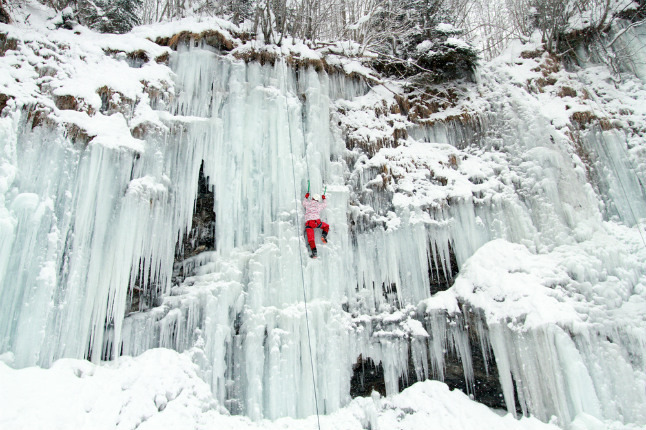Freezing Temps, Falling Ice, And Extreme Danger—Why Is Ice Climbing So Damn Popular?
Once considered a mere subset of mountaineering, ice climbing has come a long way. Armed with better equipment thrill seekers took to frozen waterfalls and steep sections of vertical ice in the twentieth century. Today, data from the Outdoor Industry Association suggests the sport of outdoor climbing has been growing and ice climbing is a major segment of that growth.
To help explain the popularity of this rugged and dangerous sport we asked two avid ice climbers to weigh in on the risks and benefits. Both Kelly Cordes, an Elite alpine climber and author of the book The Tower: A Chronicle of Climbing and Controversy on Cerro Torre, and Ian Perkins an outdoor enthusiast who has ice climbed for the past six years throughout the U.S., agree—the benefits outweigh the risks.
"Ice climbing is probably one of the most dangerous forms of climbing and the danger stretches well past the sport itself," Perkins said. "It's easy to worry about hypothermia and pack extra clothes, but people don't often consider the effects of being cold, tired and hungry. The mental hiccups that occur in decision making, risk management, and other basic moment-to-moment tasks are probably the most dangerous part of the sport."
Beyond the challenge of keeping a clear head and practicing good decision making, the sport presents dangers like falling ice, avalanches and the sharp tools athletes need to use can cause injury or sever ropes and harnesses. On top of that, falling is not an option.
"Falling on ice is strictly verboten, under the authority of good sense," Cordes said. "It isn't like sport climbing, where falls are a regular part of the game in pushing yourself. With crampons on your feet and sharp objects flying, falls on ice usually entail injury, sometimes catastrophic injury."
Despite the major risks, Cordes and Perkins continue to ice climb year after year, searching out bigger challenges and tougher terrain.
"As for my opinion on the risks, I think it's simply part of the continuum of risk and reward in life," Cordes said. "Some people find fulfillment doing things that entail little physical risk, whereas for others it's an accepted part of the adventure of life itself."
Perkins agrees, he has extensive training in both ice climbing and first aid, he knows the risks but he refuses to let fear hold him back.
"There's an addiction to climbing, it challenges both the body and the brain and provides a huge boost in confidence," Perkins said. "Every day is a mini expedition with ice climbing. It's not an easy sport to participate in; I love that it's so much more involved than a basic climbing day; there isn't a bad moment for me with ice climbing."
Cordes said he was hooked during his first time out ice climbing in 1991. "I loved the challenge of self-control amid a beautiful and chaotic environment, found it incredibly empowering and indescribably beautiful...it's so unusual to climb something so ephemeral, something that might form one day and be gone the next."
The psychological and physical challenges combined with the incredible beauty of the natural world are the biggest factors that draw Cordes and Perkins to the vertical ice.
"To be out in the forests and mountains in winter, surrounded by beauty and silence, snow blanketing the landscape and sunlight glistening off the surface, well, all of that makes for a special experience," Cordes said.
